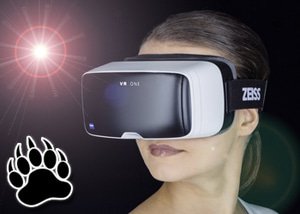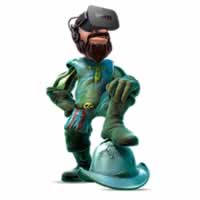Canadian online casino reviews, free casino games, casino bonuses, news, expert guides & more.
Thurs. Dec. 22, 2016

Virtual Reality (VR) has been around for a while but seems to have really taken off in 2016 with more and more industries incorporating it into their daily lives. VR is a computer-created world that users can enter and become a part of using a VR headset. In a recent interview with GrizzlyGambling, Sam Forrest of KamaGames described it saying, "VR technology allows you to immerse yourself in a computer-generated world or environment via the use of goggles and controllers that allow you to look around and interact with the world itself and any objects within".
The first VR helmet was sold by Sega over 20 years ago, and today there are four big names to watch. These are Sony, HTC, OSVR, and Oculus Rift. There are many fields using the technology and the most exciting development has to be the introduction of virtual reality in online casinos.
Virtual Reality is growing at an exceptional rate. Revenues from VR hardware and software products came in at $90 million USD in 2014 and it's estimated that this figure will rise to $5.2 billion USD in 2018. The number of users is also expected to reach approximately 171 million by 2018. So what would VR in online casinos be like? Well, imagine walking through a casino, but in reality walking around your living room.
Virtual Reality is growing at an exceptional rate.
New research data from Juniper Research found that gross wagers from virtual reality gambling will grow to approximately $520 million by 2021. This is an increase of 800% compared to this year's figures of $58.5 million. Juniper's research on mobile and online gambling found that VR gambling over the next five years will be focused on the casino space and will offer real world VR locations. That means you can visit a Las Vegas casino without ever leaving your home.
 Slots Million: The launch of the Oculus Rift headset brought with it the launch of the first VR casino. SlotsMillion VR Casino allows players to control the games using a keyword or game controller and the VR casino app consists of 40 casino games and slots. The immersive lobby has been designed as a slots casino with slot machines, music, bars, and lounge couches. The casino itself is located on the 80th floor of a skyscraper and players get to enjoy looking out at a futuristic cityscape. You can even lean against the window and look down. Once players wear the Oculus Rift headset they can interact with the environment just as they would in a land-based casino.
Slots Million: The launch of the Oculus Rift headset brought with it the launch of the first VR casino. SlotsMillion VR Casino allows players to control the games using a keyword or game controller and the VR casino app consists of 40 casino games and slots. The immersive lobby has been designed as a slots casino with slot machines, music, bars, and lounge couches. The casino itself is located on the 80th floor of a skyscraper and players get to enjoy looking out at a futuristic cityscape. You can even lean against the window and look down. Once players wear the Oculus Rift headset they can interact with the environment just as they would in a land-based casino.
 Microgaming VR Games: Microgaming showcased their VR Roulette prototype in their CRYO Lab at ICE Totally Gaming 2016. They have also designed other VR apps and augmented reality betting apps to work with Google Glass. VR Roulette works with the Oculus Rift D Kit 2 and the Leap Motion 3D Controller and you can find out all about this in the piece we wrote earlier this year on Microgaming bringing virtual reality to online gambling. Microgaming's VR display was one of the main highlights of this year's ICE 2016. This 3D exhibit showcased the company's widespread R&D drive for their preparation of the Virtual Reality technology of the industry. The new product was designed in Cryolab and was done exclusively for ICE 2016.
Microgaming VR Games: Microgaming showcased their VR Roulette prototype in their CRYO Lab at ICE Totally Gaming 2016. They have also designed other VR apps and augmented reality betting apps to work with Google Glass. VR Roulette works with the Oculus Rift D Kit 2 and the Leap Motion 3D Controller and you can find out all about this in the piece we wrote earlier this year on Microgaming bringing virtual reality to online gambling. Microgaming's VR display was one of the main highlights of this year's ICE 2016. This 3D exhibit showcased the company's widespread R&D drive for their preparation of the Virtual Reality technology of the industry. The new product was designed in Cryolab and was done exclusively for ICE 2016.
 NetEnt VR Games: NetEnt has been exploring VR technology and focusing on 3D sound because they believe that sound enhances a player's gaming experience. They are implementing 3D sound technology into their VR slots and casino games. At ICE 2016, NetEnt demonstrated their VR slots game Jack's 3D World. They later added a video of Jacks World in VR on their YouTube channel so anyone with Google Cardboard can enjoy it.
NetEnt VR Games: NetEnt has been exploring VR technology and focusing on 3D sound because they believe that sound enhances a player's gaming experience. They are implementing 3D sound technology into their VR slots and casino games. At ICE 2016, NetEnt demonstrated their VR slots game Jack's 3D World. They later added a video of Jacks World in VR on their YouTube channel so anyone with Google Cardboard can enjoy it.
There are a wide number of industries that come to mind when thinking about virtual reality outside of online casinos. These include gaming, education, and film. In fact, there are at least 10 other industries that already use VR. We have listed these below:
Over the past 12 months alone, $2.3 billion has been invested in AR and VR , according to investment banking firm Digi-Capital. This is a massive amount, and $500 million of this was invested in the last quarter. This is a very clear sign that the financial world sees AR and VR as potential boom markets. There has been significant backing from financial institutions for the development of hardware.
While virtual reality is an amazing technology with so many promises, there are some negatives that we need to share.
VR and AR are two words that you will see a lot of nowadays and in the future, but you may be wondering what their differences are.
Virtual Reality (VR) is a computer-generated simulation that immerses the users through the use of a headset. Users feel like they are experiencing the simulated reality first hand through the use of their vision and hearing.
Augmented Reality (AR) layers computer-generated enhancements onto an existing reality to make it more meaningful for users to interact with it. AR is developed into apps and used on mobile devices. A headset is not required to use AR.
Some examples of Augmented Reality Apps include:
We asked Sam Forrest of KamaGames what he saw for the future of VR and AR and he said, "I think we are going to see AR become a lot more established quicker than VR simply because the entry to market is that much lower and easier (cost, no need for headsets, etc.) and let's face it, Pokemon Go really hasn't done AR technology any harm by introducing it to the masses with a pretty impressive 500+ million downloads of the game since launch!"
We will see an increase in the amount of VR being used in people's homes.
Will we see simulators and headsets in our everyday home environment in the near future? That's a tricky question and it really is impossible to predict the future of VR. In order to see virtual reality really take off, the price of the hardware may need to come down in price. For now, gadget and technology enthusiasts, and those with the money to spend will lead the way with VR in the home. As the price of headsets decreases, we will see an increase in the amount of VR being used in people's homes. This may take a couple of years and we could see online games of the future taking place in virtual reality. We could even see this technology being used to allow users visit friends and family who live far away without having to leave their living room.
The future of VR is one that is difficult to predict. The user uptake is hindered by the high cost of headsets at the moment but this could all change. It is expected that virtual reality in online casinos will grow and may very well account for 40% of the total gross gambling wagers by 2021 according to Juniper Research. By that time we are sure to see more virtual reality games being released by Microgaming and NetEnt and there are bound to be a couple of other software providers getting in on the action too. The success of SlotsMillion has proved that VR casinos are popular with players and the more people who acquire VR headsets, the more there will be to test out this unique online gambling experience.




Be the first to know about new online casinos, the latest free slots games and receive exclusive promotions. We guarantee privacy, so your email is safe and secure.

Welcome to grizzlygambling.com - the whole team welcomes you to our player community. It is our mission to inform members of the latest events on the Canadian market so you can enjoy the best in online casino gambling.